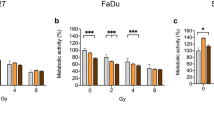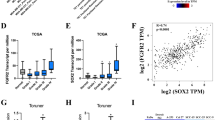Abstract
Purpose
The hedgehog signalling pathway (Hh) is frequently active in head and neck squamous cell carcinoma (HNSCC). Overexpressed Hh associates with poor prognosis. The Hh inhibitor vismodegib targets smoothened, and based on molecular data, may prevent resistance to EGFR targeting.
Methods
To elucidate potential roles of vismodegib in HNSCC therapy, its sole effects and those combined with cisplatin, docetaxel, and cetuximab on HNSCC cell lines were assessed by MTT metabolisation and BrdU incorporation. Colony formation (CF) of primary HNSCC cells was studied utilizing the FLAVINO-protocol. Combinatory effects were analysed regarding antagonism, additivity or synergism. Associations between the ex vivo detected mode of action of vismodegib with other treatments related to patient characteristics were assessed and progression-free survival (PFS) in patient groups compared using Kaplan–Meier curves.
Results
Vismodegib suppressed BrdU incorporation significantly stronger than MTT turnover; CF was significantly inhibited at ≥20 µM vismodegib while concentrations <20 µM acted hormetic. Combining 20 µM vismodegib plus docetaxel (T), cisplatin (P), and cetuximab (E), additively enhanced anti-tumoral activity in HNSCC samples from patients with superior PFS highlighting a potential role for ex-vivo testing of this combination for use as a prognostic classifier.
Conclusion
We provide ex-vivo evidence for vismodegib’s potential in HNSCC therapies, especially if combined with cetuximab, cisplatin and docetaxel.





Similar content being viewed by others
References
Zigon G, Berrino F, Gatta G et al (2011) Prognoses for head and neck cancers in Europe diagnosed in 1995–1999: a population-based study. Ann Oncol 22:165–174. doi:10.1093/annonc/mdq306
Ferlay J, Steliarova-Foucher E, Lortet-Tieulent J et al (2013) Cancer incidence and mortality patterns in Europe: estimates for 40 countries in 2012. Eur J Cancer 49:1374–1403. doi:10.1016/j.ejca.2012.12.027
Macfarlane GJ, Zheng T, Marshall JR et al (1995) Alcohol, tobacco, diet and the risk of oral cancer. A pooled analysis of three case–control studies. Eur J Cancer Part B Oral Oncol 31:181–187. doi:10.1016/0964-1955(95)00005-3
Andl T, Kahn T, Pfuhl A et al (1998) Etiological involvement of oncogenic human papillomavirus in tonsillar squamous cell carcinomas lacking retinoblastoma cell cycle control. Cancer Res 58:5–13
Gillison ML (2000) Evidence for a causal association between human papillomavirus and a subset of head and neck cancers. J Ntnl Cancer Inst 92:709–720. doi:10.1093/jnci/92.9.709
Seshacharyulu P, Ponnusamy MP, Haridas D, Jain M, Ganti AK, Batra SK (2012) Targeting the EGFR signaling pathway in cancer therapy. Expert Opin Ther Targets 16:15–31. doi:10.1517/14728222.2011.648617
Grandis JR, Tweardy DJ (1993) Elevated levels of transforming growth factor alpha and epidermal growth factor receptor messenger RNA are early markers of carcinogenesis in head and neck cancer. Cancer Res 53:3579–3584
Bonner JA, Harari PM, Giralt J et al (2006) Radiotherapy plus cetuximab for squamous-cell carcinoma of the head and neck. N Engl J Med 354:567–578. doi:10.1056/NEJMoa053422
Rivera F, García-Castaño A, Vega N, Vega-Villegas ME, Gutiérrez-Sanz L (2009) Cetuximab in metastatic or recurrent head and neck cancer: the EXTREME trial. Expert Rev Anticancer Ther 9:1421–1428. doi:10.1586/era.09.113
Dietz A, Boehm A, Mozet C, Wichmann G, Giannis A (2008) Current aspects of targeted therapy in head and neck tumors. Eur Arch Otorhinolaryngol 265(Suppl 1):S3–S12. doi:10.1007/s00405-008-0697-6
Scales SJ, Sauvage FJ de (2009) Mechanisms of hedgehog pathway activation in cancer and implications for therapy. Trends Pharmacol Sci 30:303–312. doi:10.1016/j.tips.2009.03.007
Fujii K, Miyashita T (2014) Gorlin syndrome (nevoid basal cell carcinoma syndrome): update and literature review. Pediatr Int 56:667–674. doi:10.1111/ped.12461
Romer J, Curran T (2005) Targeting medulloblastoma: small-molecule inhibitors of the sonic hedgehog pathway as potential cancer therapeutics. Cancer Res 65:4975–4978. doi:10.1158/0008-5472.CAN-05-0481
Varnat F, Duquet A, Malerba M et al (2009) Human colon cancer epithelial cells harbour active HEDGEHOG-GLI signalling that is essential for tumour growth, recurrence, metastasis and stem cell survival and expansion. EMBO Mol Med 1:338–351. doi:10.1002/emmm.200900039
Berman DM, Karhadkar SS, Maitra A et al (2003) Widespread requirement for hedgehog ligand stimulation in growth of digestive tract tumours. Nature 425:846–851. doi:10.1038/nature01972
Watkins DN, Berman DM, Burkholder SG, Wang B, Beachy PA, Baylin SB (2003) Hedgehog signalling within airway epithelial progenitors and in small-cell lung cancer. Nature 422:313–317. doi:10.1038/nature01493
Karhadkar SS, Bova GS, Abdallah N et al (2004) Hedgehog signalling in prostate regeneration, neoplasia and metastasis. Nature 431:707–712. doi:10.1038/nature02962
Chung CH, Dignam JJ, Hammond ME et al (2011) Glioma-associated oncogene family zinc finger 1 expression and metastasis in patients with head and neck squamous cell carcinoma treated with radiation therapy (RTOG 9003). J Clin Oncol 29:1326–1334. doi:10.1200/JCO.2010.32.3295
Dimitrova K, Stoehr M, Dehghani F et al (2013) Overexpression of the hedgehog signalling pathway in head and neck squamous cell carcinoma. Onkologie 36:279–286. doi:10.1159/000350322
Fertig EJ, Markovic A, Danilova LV et al (2013) Preferential activation of the hedgehog pathway by epigenetic modulations in HPV negative HNSCC identified with meta-pathway analysis. PLoS One 8:e78127. doi:10.1371/journal.pone.0078127
Keysar SB, Le PN, Anderson RT et al (2013) Hedgehog signaling alters reliance on EGF receptor signaling and mediates anti-EGFR therapeutic resistance in head and neck cancer. Cancer Res 73:3381–3392. doi:10.1158/0008-5472.CAN-12-4047
Gan GN, Eagles J, Keysar SB et al (2014) Hedgehog signaling drives radioresistance and stroma-driven tumor repopulation in head and neck squamous cancers. Cancer Res 74:7024–7036. doi:10.1158/0008-5472.CAN-14-1346
Mozet C, Stoehr M, Dimitrova K, Dietz A, Wichmann G (2013) Hedgehog targeting by cyclopamine suppresses head and neck squamous cell carcinoma and enhances chemotherapeutic effects. Anticancer Res 33:2415–2424
Sekulic A, Migden MR, Oro AE et al (2012) Efficacy and safety of vismodegib in advanced basal-cell carcinoma. N Engl J Med 366:2171–2179. doi:10.1056/NEJMoa1113713
Dietz A, Tschöp K, Wichmann G, Granzow C (2015) Method and kit for the ex vivo evaluation of the response of a tumor to conditions to be tested 09.04.2009. Accessed 10 Sep 2015
Dietz A, Boehm A, Horn I et al (2010) Assay-based response evaluation in head and neck oncology: requirements for better decision making. Eur Arch Otorhinolaryngol 267:483–494. doi:10.1007/s00405-009-1191-5
Horn I, Wichmann G, Mozet C et al (2010) Heterogeneity of epithelial and stromal cells of head and neck squamous cell carcinomas in ex vivo chemoresponse. Cancer Chemother Pharmacol 65:1153–1163. doi:10.1007/s00280-009-1124-4
Stoehr M, Mozet C, Boehm A, Aigner A, Dietz A, Wichmann G (2014) Simvastatin suppresses head and neck squamous cell carcinoma ex vivo and enhances the cytostatic effects of chemotherapeutics. Cancer Chemother Pharmacol 73:827–837. doi:10.1007/s00280-014-2412-1
Schrader C, Boehm A, Reiche A, Dietz A, Mozet C, Wichmann G (2012) Combined effects of lapatinib and cisplatin on colony formation of head and neck squamous cell carcinoma. Anticancer Res 32:3191–3199
Zhao M, Sano D, Pickering CR et al (2011) Assembly and initial characterization of a panel of 85 genomically validated cell lines from diverse head and neck tumor sites. Clin Cancer Res 17:7248–7264. doi:10.1158/1078-0432.CCR-11-0690
Sobin LH, Gospodarowicz MK, Wittekind C (2010) TNM classification of malignant tumours. Wiley, Oxford
Qualtrough D, Rees P, Speight B, Williams AC, Paraskeva C (2015) The hedgehog inhibitor cyclopamine reduces β-catenin-Tcf transcriptional activity, induces E-cadherin expression, and reduces invasion in colorectal cancer cells. Cancers 7:1885–1899. doi:10.3390/cancers7030867
Yoo YA, Kang MH, Lee HJ et al (2011) Sonic hedgehog pathway promotes metastasis and lymphangiogenesis via activation of Akt, EMT, and MMP-9 pathway in gastric cancer. Cancer Res 71:7061–7070. doi:10.1158/0008-5472.CAN-11-1338
Bora-Singhal N, Perumal D, Nguyen J, Chellappan S (2015) Gli1-mediated regulation of Sox2 facilitates self-renewal of stem-like cells and confers resistance to EGFR inhibitors in non-small cell lung cancer. Neoplasia (New York, N.Y.) 17:538–551. doi:10.1016/j.neo.2015.07.001
Zahreddine HA, Culjkovic-Kraljacic B, Assouline S et al (2014) The sonic hedgehog factor GLI1 imparts drug resistance through inducible glucuronidation. Nature 511:90–93. doi:10.1038/nature13283
Della Corte CM, Bellevicine C, Vicidomini G et al (2015) SMO gene amplification and activation of the hedgehog pathway as novel mechanisms of resistance to anti-epidermal growth factor receptor drugs in human lung cancer. Clin Cancer Res 21:4686–4697. doi:10.1158/1078-0432.CCR-14-3319
Bowles DW, Keysar SB, Glogowska MJ et al (2014) A pilot study of cetuximab and the hedgehog inhibitor IPI-926 in recurrent/metastatic (R/M) head-and-neck squamous cell carcinoma. Int J Radiat Oncol Biol Phys 88:511. doi:10.1016/j.ijrobp.2013.11.152
Singh S, Wang Z, Liang Fei D et al (2011) Hedgehog-producing cancer cells respond to and require autocrine hedgehog activity. Cancer Res 71:4454–4463. doi:10.1158/0008-5472.CAN-10-2313
Yauch RL, Gould SE, Scales SJ et al (2008) A paracrine requirement for hedgehog signalling in cancer. Nature 455:406–410. doi:10.1038/nature07275
Rhim AD, Oberstein PE, Thomas DH et al (2014) Stromal elements act to restrain, rather than support, pancreatic ductal adenocarcinoma. Cancer cell 25:735–747. doi:10.1016/j.ccr.2014.04.021
Chun SG, Park H, Pandita RK et al (2015) Targeted inhibition of histone deacetylases and hedgehog signaling suppress tumor growth and homologous recombination in aerodigestive cancers. Am J Cancer Res 5:1337–1352
Brechbiel J, Miller-Moslin K, Adjei AA (2014) Crosstalk between hedgehog and other signaling pathways as a basis for combination therapies in cancer. Cancer Treat Rev 40:750–759. doi:10.1016/j.ctrv.2014.02.003
Calabrese EJ, Nascarella MA (2010) Tumor resistance explained by hormesis. Dose Response 8:80–82. doi:10.2203/dose-response.09-063.Calabrese
Graham RA, Lum BL, Cheeti S et al (2011) Pharmacokinetics of hedgehog pathway inhibitor vismodegib (GDC-0449) in patients with locally advanced or metastatic solid tumors: the role of alpha-1-acid glycoprotein binding. Clin Cancer Res 17:2512–2520. doi:10.1158/1078-0432.CCR-10-2736
Gajjar AJ, Gururangan S, Qaddoumi IA et al (2013) A prospective phase II study to determine the efficacy of GDC 0449 (vismodegib) in adults with recurrent medulloblastoma (MB): a Pediatric Brain Tumor Consortium study (PBTC 25B). J Clin Oncol 31:suppl; abstr 2035
Berlin J, Bendell JC, Hart LL et al (2013) A randomized phase II trial of vismodegib versus placebo with FOLFOX or FOLFIRI and bevacizumab in patients with previously untreated metastatic colorectal cancer. Clin Cancer Res 19:258–267. doi:10.1158/1078-0432.CCR-12-1800
Kaye SB, Fehrenbacher L, Holloway R et al (2012) A phase II, randomized, placebo-controlled study of vismodegib as maintenance therapy in patients with ovarian cancer in second or third complete remission. Clin Cancer Res 18:6509–6518. doi:10.1158/1078-0432.CCR-12-1796
Kim EJ, Sahai V, Abel EV et al (2014) Pilot clinical trial of hedgehog pathway inhibitor GDC-0449 (vismodegib) in combination with gemcitabine in patients with metastatic pancreatic adenocarcinoma. Clin Cancer Res 20:5937–5945. doi:10.1158/1078-0432.CCR-14-1269
Acknowledgements
We thank Anett Reiche for excellent technical assistance and the patients and their families for participation in the study.
Author information
Authors and Affiliations
Corresponding author
Ethics declarations
Funding
The study was supported by the Grant EPGZ268406-G from Roche Pharma AG.
Conflict of interest
Gunnar Wichmann received funding for a translational research project on “Efficacy of vismodegib (GDC-0449) on HNSCC ex vivo, EPGZ268406-G” from Roche Pharma AG. All other authors declare no conflict of interest.
Ethical approval
The study was performed in accordance with the ethical standards as laid down in the 1964 declaration of Helsinki and its later amendments (vote 201-10-12072010 of the local ethics committee at the Medical Faculty of the University Leipzig).
Additional information
H. Liebig and G. Günther equally contributed to the paper.
Rights and permissions
About this article
Cite this article
Liebig, H., Günther, G., Kolb, M. et al. Reduced proliferation and colony formation of head and neck squamous cell carcinoma (HNSCC) after dual targeting of EGFR and hedgehog pathways. Cancer Chemother Pharmacol 79, 411–420 (2017). https://doi.org/10.1007/s00280-017-3239-3
Received:
Accepted:
Published:
Issue Date:
DOI: https://doi.org/10.1007/s00280-017-3239-3




